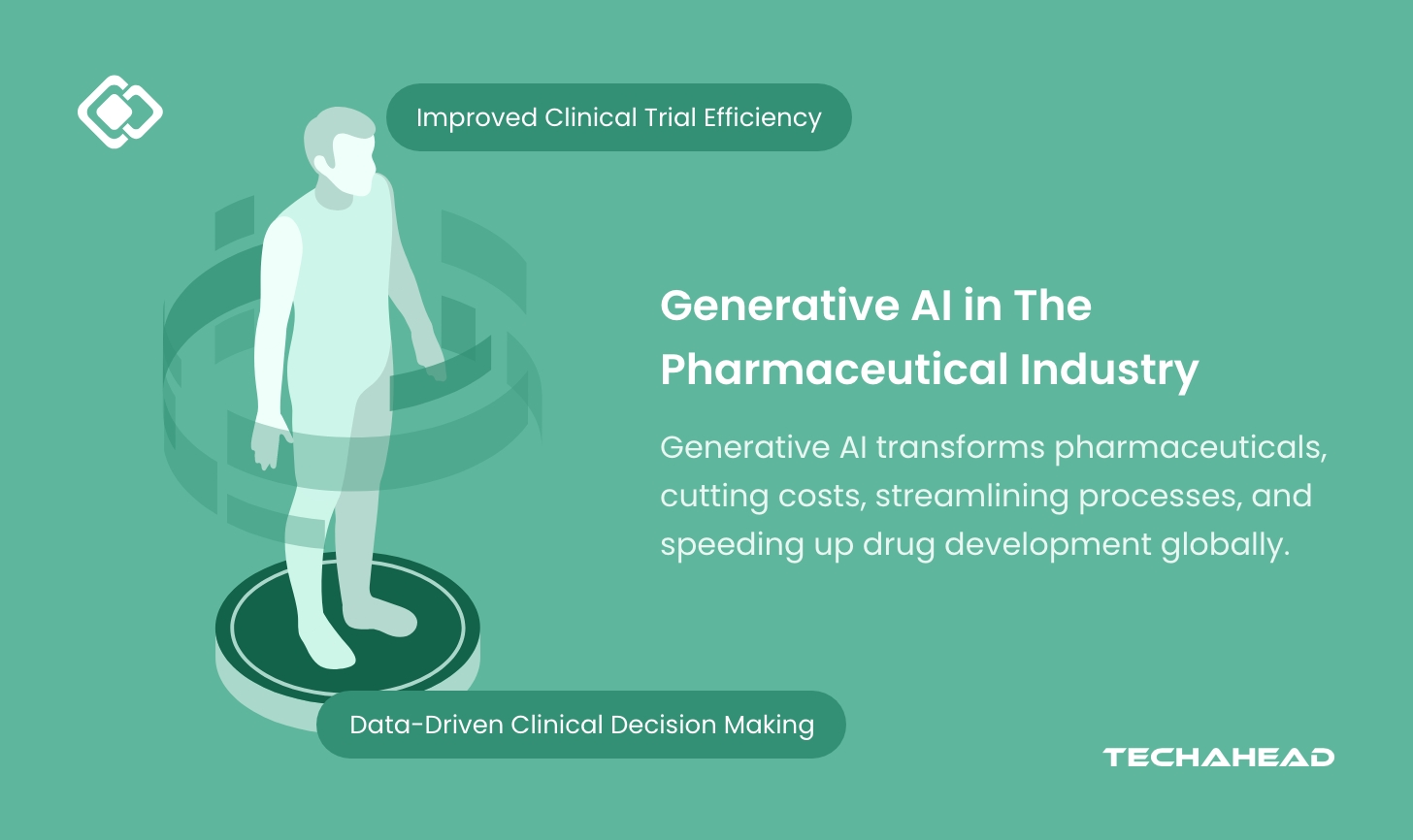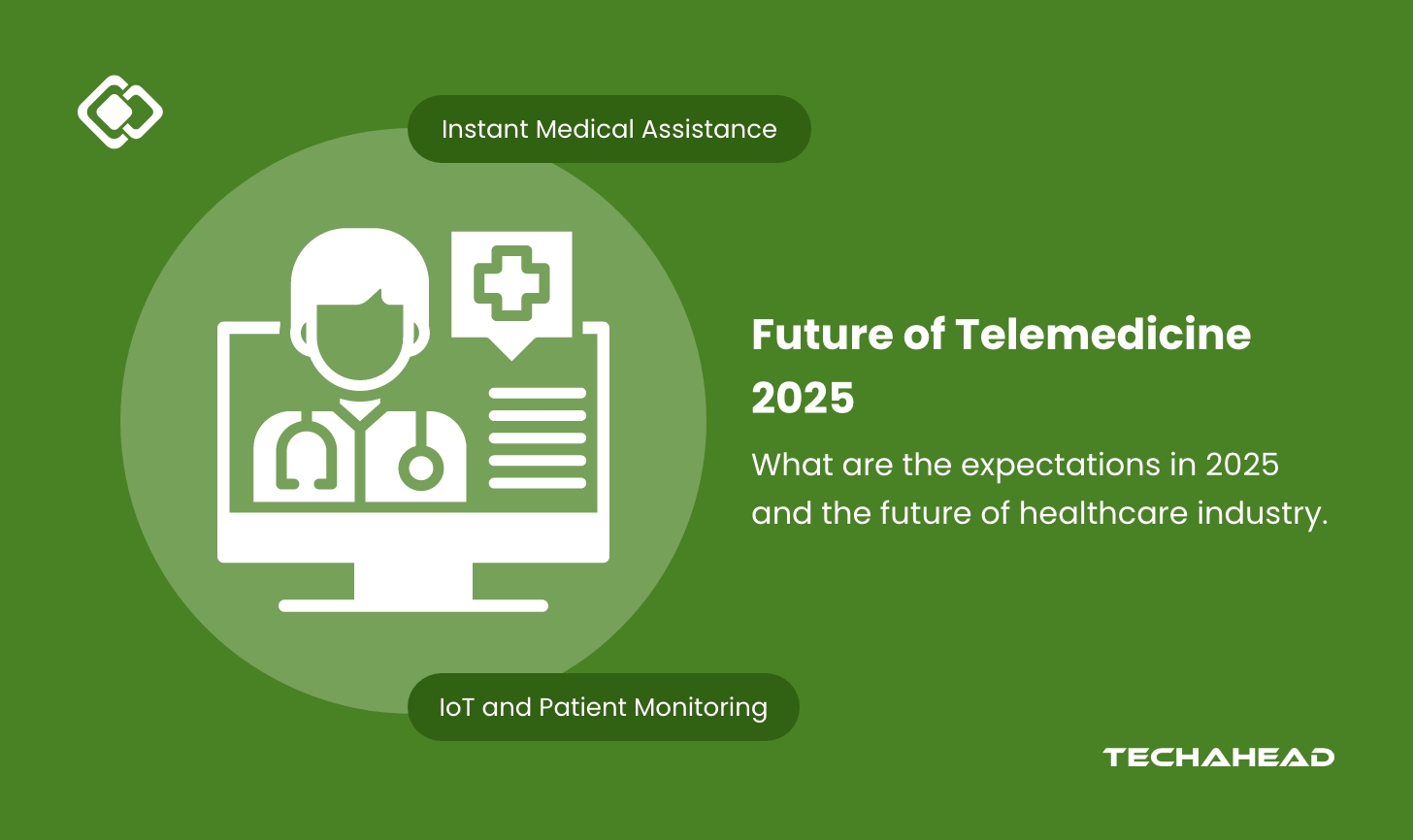
Imagine undergoing a comprehensive health check-up without leaving your home, with seamless data sharing among your healthcare providers. This once-distant vision is now becoming a reality, fueled by surging patient demand and technological advancements.
The global telehealth and telemedicine market is projected to skyrocket from $120.4 billion in 2023 to an impressive $285.7 billion by 2028. This remarkable growth, at a CAGR of 23.2%, is driven by several key factors. These include a growing global population, an urgent need to improve healthcare access, and the rising prevalence of chronic conditions. Additionally, a shortage of healthcare professionals, advancements in telecommunication, and strong government support further propel this expansion. However, challenges such as regulatory differences, fraud concerns, and misuse of social media for healthcare delivery could dampen growth in specific regions.
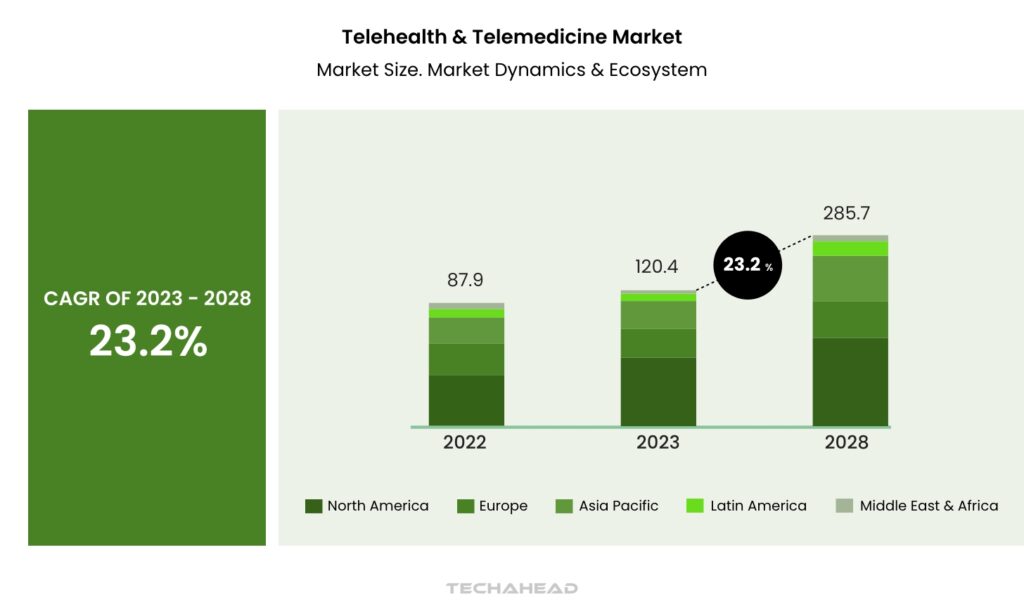
By harnessing cutting-edge technology, telehealth and telemedicine are transforming healthcare delivery into a more patient-centric approach. These solutions are rapidly emerging as the go-to choice for medical consultations due to their convenience and efficiency. As the industry evolves, it is moving beyond simple virtual appointments to embrace hybrid care models. This approach blends the advantages of online consultations with essential in-person interactions for more comprehensive care.
By 2025, telemedicine is set to redefine health and wellness, emphasizing integration, accessibility, and personalized care. These trends are paving the way for a new era in healthcare, offering unlimited opportunities and innovative possibilities for telehealth solutions. Stay ahead by exploring the top emerging trends shaping the future of this transformative industry.
Top Trends Shaping Telemedicine in 2025
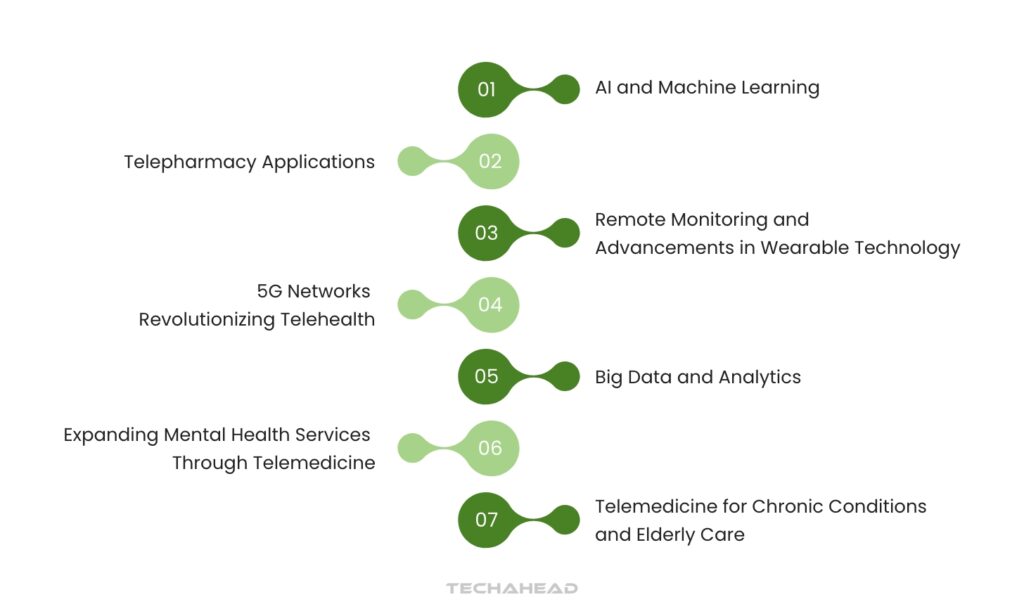
AI and Machine Learning
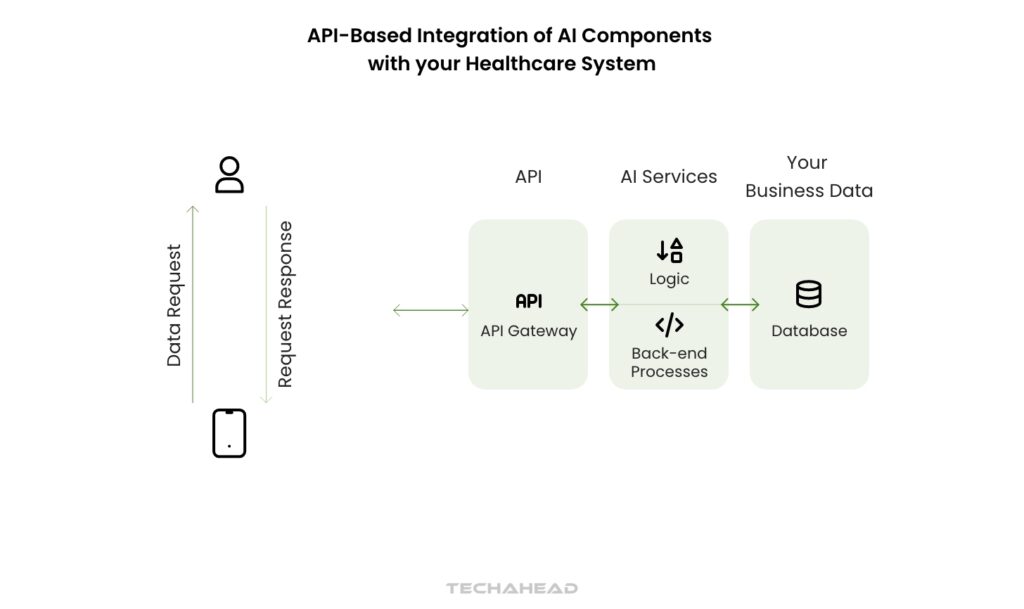
AI and machine learning are set to redefine telehealth in 2025. AI-powered healthcare solutions will analyze real-time patient data, helping medical professionals make quick, informed decisions. For example, AI virtual assistants can automate routine tasks like symptom checks, scheduling, and patient triage, boosting efficiency.
Machine learning models will enhance telemedicine platforms with predictive analytics and personalized treatment plans. This advancement allows healthcare providers to deliver precision care tailored to individual needs. The demand for telemedicine apps with AI-driven features will rise as these innovations improve patient outcomes.
Telepharmacy Applications
Telepharmacy is emerging as a key focus in telehealth, with significant growth projected for 2025. Unlike general telehealth services, which are seeing reduced coverage, telepharmacy is gaining traction due to its ability to remotely prescribe and distribute medications. This advancement highlights its importance in modern healthcare.
In November 2024, the Drug Enforcement Administration (DEA) extended telepharmacy regulations, allowing digital prescriptions for controlled substances until December 31, 2025. This marks the third consecutive extension, underscoring the growing trust in remote pharmaceutical systems. Such regulatory flexibility promises a bright future for telepharmacy innovations.
The convenience of telepharmacy addresses a critical gap in healthcare access. Many patients struggle to visit pharmacies due to mobility issues or personal discomfort. Telecommunication apps bridge this gap by enabling patients to receive prescriptions and medication without leaving their homes.
One of the most notable beneficiaries of telepharmacy is the growing segment of GLP-1 weight loss treatments. These medications are gaining popularity, and telepharmacy ensures timely and seamless delivery to patients.
The rise of telepharmacy not only enhances patient convenience but also strengthens healthcare providers’ ability to cater to evolving demands. As digital tools advance, telepharmacy will become a cornerstone of accessible and efficient pharmaceutical care.
Remote Monitoring and Advancements in Wearable Technology
Wearable health devices like smartwatches and fitness trackers will dominate telehealth trends in 2025. These gadgets monitor vital metrics such as heart rate, blood pressure, and oxygen levels in real-time. The data collected helps healthcare providers manage chronic conditions proactively and deliver personalized care.
By 2025, tighter integration between wearables and telemedicine platforms will enable real-time alerts for abnormal readings. This ensures faster response times from healthcare professionals. Remote monitoring will empower patients to take control of their health while improving clinical decision-making for providers.
5G Networks Revolutionizing Telehealth
The widespread rollout of 5G will be a game-changer for telemedicine. Faster speeds and low latency will enhance virtual consultations, offering high-definition video interactions that mimic in-person visits.
5G will also bridge the connectivity gap in underserved rural areas. Improved access will make high-quality telemedicine services available to patients in remote locations. This connectivity boost will help expand telehealth adoption, especially among populations with limited access to traditional healthcare.
Big Data and Analytics
Big Data and Analytics are reshaping telehealth by unlocking insights from vast healthcare records in developed nations like the U.S. Advanced data-mining techniques are now capable of identifying patterns in pandemics, chronic diseases, and other health phenomena. These insights enable healthcare providers to respond faster and more effectively to emerging medical challenges.
The wealth of clinical data generated from electronic health records (EHRs) is driving this transformation. These records, combined with data from wearable devices and remote patient monitoring tools, offer an unprecedented opportunity for data-driven healthcare.
By analyzing millions of medical cases, healthcare professionals can make evidence-based decisions that improve care quality. For example, providers can identify disease trends, predict outbreaks, and design targeted treatments using these insights.
Additionally, integrating analytics into telehealth platforms allows for better patient engagement and outcomes. Healthcare organizations can personalize care plans and address individual needs with a greater level of precision. As Big Data continues to evolve, telehealth will become a more proactive, efficient, and evidence-backed domain in the healthcare industry.
Expanding Mental Health Services Through Telemedicine
Telemedicine will play a vital role in mental health care by 2025. Currently popular for virtual counseling and therapy, telemedicine platforms will soon offer holistic mental health solutions.
New features like mental health assessments, self-help tools, and therapy modules will enhance care delivery. These advancements will reduce the stigma surrounding mental health care, offering patients a private and convenient way to seek help. As telemedicine becomes more inclusive, it will significantly improve mental health outcomes for diverse populations.
Telemedicine for Chronic Conditions and Elderly Care
Patients with chronic illnesses and elderly individuals will greatly benefit from telemedicine innovations in 2025. These platforms will enable real-time health monitoring and customized care plans, reducing the need for frequent in-person visits.
Specialized telemedicine apps for elderly care will include features like medication reminders, simple interfaces, and easy navigation. These innovations will improve the quality of life for elderly patients, ensuring they receive consistent and compassionate care. Tailored telemedicine solutions will empower providers to meet the unique needs of specific patient groups.
Telemedicine in 2025 will continue to evolve, leveraging technology to enhance care quality, accessibility, and patient satisfaction.
Role of Telemedicine Applications in the Future of the Healthcare Industry
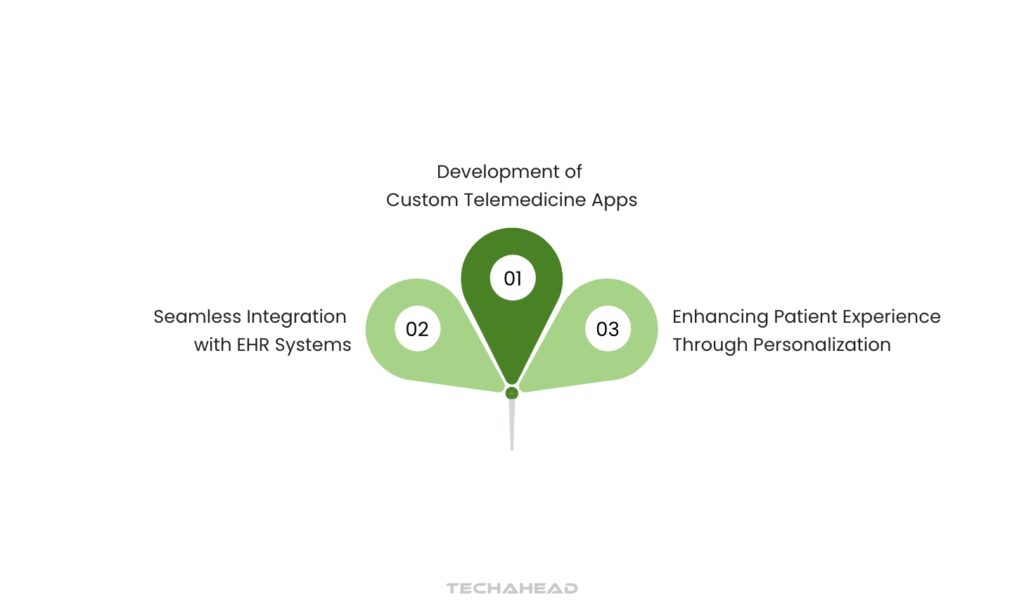
Development of Custom Telemedicine Apps
The demand for tailored telemedicine apps is set to surge as healthcare evolves. These apps will provide virtual consultations, AI-driven diagnostics, remote monitoring, and personalized health plans, ensuring patient-centric care. Specialized applications for areas like cardiology, dermatology, and mental health will empower providers to address specific conditions effectively.
By 2025, personalized telemedicine solutions will be indispensable for enhancing healthcare access and patient outcomes. These custom apps will enable healthcare professionals to deliver precise care that aligns with each patient’s unique needs, ensuring a more efficient and targeted approach to treatment.
Seamless Integration with EHR Systems
A major advancement in telehealth by 2025 will be the seamless integration of telemedicine apps with electronic health records (EHRs). This interoperability will allow platforms to access patient data from EHRs, providing healthcare providers with a comprehensive view during virtual consultations.
This integration will streamline decision-making, minimize medical errors, and elevate care quality. Providers will benefit from a holistic understanding of patients’ medical histories, ensuring accurate diagnoses and effective treatment plans.
Enhancing Patient Experience Through Personalization
Personalized care will dominate telemedicine trends, driven by increasing patient expectations. Future telemedicine apps will monitor patient progress, offer tailored health recommendations, and schedule follow-ups based on individual health data.
This level of customization will improve patient engagement and foster adherence to treatment plans. A more personalized approach will lead to better healthcare outcomes by addressing individual needs more effectively.
With advanced capabilities, telemedicine apps will transform healthcare delivery, making it more accessible, precise, and patient-focused. The future of telemedicine will rely heavily on technology-driven innovation to meet the growing demand for personalized, high-quality care.
Challenges of Integrating AI in Telehealth
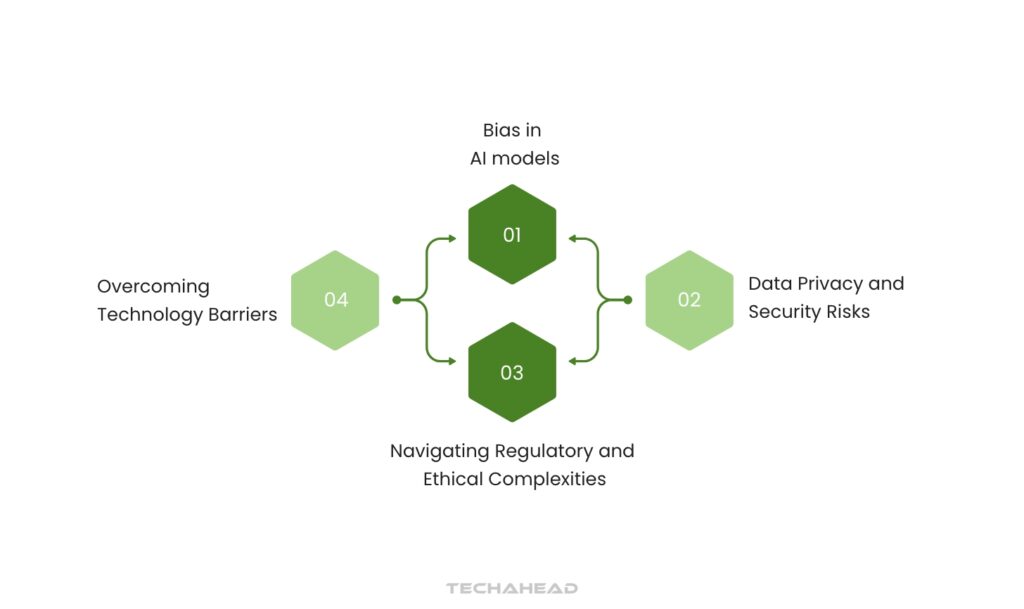
Bias in AI models
AI systems often have inherent biases from the data used to train them, which may not represent diverse patient demographics. These biases could result in inaccurate or even discriminatory medical recommendations, potentially harming patient trust and care quality.
To address this, developers should implement advanced bias-reduction techniques and conduct rigorous fairness assessments. These steps ensure AI systems provide equitable and reliable healthcare solutions for all populations.
Data Privacy and Security Risks
AI systems rely on extensive data for training, raising significant concerns about data privacy and security. Sensitive patient information could be at risk, especially when third-party computational resources are involved.
To mitigate these risks, healthcare institutions might adopt localized hosting solutions for AI models, reducing dependence on external systems and safeguarding data integrity. This approach enhances trust while ensuring compliance with privacy regulations.
Navigating Regulatory and Ethical Complexities
The integration of AI in telehealth requires navigating intricate regulatory frameworks and ethical dilemmas. Compliance with healthcare laws is critical, as is addressing ethical questions about the extent of AI’s decision-making capabilities. Establishing transparent guidelines and clear accountability for AI tools can promote their ethical use and ensure alignment with healthcare standards. These measures are vital for fostering trust in AI-powered telehealth solutions.
Overcoming Technology Barriers
The lack of technological proficiency among healthcare staff presents a significant hurdle in adopting AI tools. Frontline providers often require comprehensive digital training to effectively utilize these advanced technologies. Offering accessible training programs and user-friendly tools can empower healthcare professionals, ensuring they are well-equipped to integrate AI seamlessly into their daily workflows. This step is crucial for maximizing AI’s potential in telehealth.
By addressing these challenges strategically, healthcare organizations can unlock the transformative potential of AI while maintaining ethical, secure, and patient-centered practices.
Benefits of Telemedicine in Healthcare

Telemedicine offers numerous benefits for patients, healthcare providers, and institutions, making it a transformative force in modern healthcare. It’s endorsed by global organizations like WHO due to its potential to revolutionize accessibility, efficiency, and quality in healthcare delivery. Let’s delve into the key advantages of telemedicine and its profound impact.
Easy Access to Healthcare
Telemedicine simplifies access to medical services, especially for rural communities with limited healthcare facilities. Patients can consult doctors via mobile apps, avoiding the need for long-distance travel. For example, a patient with mild breathing issues can instantly connect with a doctor, receive a diagnosis, and get prescriptions to manage symptoms. This accessibility ensures timely care, reducing the burden of in-person visits unless necessary.
Instant Medical Assistance
When immediate care is needed, telemedicine offers a lifeline by providing rapid access to medical professionals. Delays in seeking care for urgent conditions can worsen patient outcomes. Telemedicine eliminates these delays by enabling real-time virtual consultations. For example, a patient with severe pain can receive guidance within minutes, potentially saving lives. Moreover, medical professionals can collaborate instantly with peers for advice on complex cases or surgeries, enhancing care delivery.
IoT and Patient Monitoring
Telemedicine, integrated with IoT-enabled devices, revolutionizes patient monitoring. Devices like heart rate monitors, glucose trackers, and medical alert systems collect real-time health data. This data empowers patients to take proactive measures while helping doctors monitor conditions remotely. For instance, a diabetic patient can track glucose levels and receive timely advice from their doctor, preventing complications and improving overall health outcomes.
Electronic Health Record (EHR)
EHR systems, enhanced by telemedicine, provide seamless access to medical histories, prescriptions, and diagnoses. Patients and doctors benefit from quick, secure access to records, ensuring better care coordination. Governments and insurers in the U.S. actively promote EHR adoption, recognizing its advantages. Benefits include improved documentation, data recovery, secure information exchange, and faster prescription processing. These features enhance efficiency, privacy, and collaboration among healthcare providers.
Better Pediatric Care
Telemedicine transforms pediatric care by offering parents instant access to doctors and real-time monitoring tools. IoT-enabled devices track vital signs, enabling early intervention and preventive care. Parents can quickly consult doctors for common concerns, ensuring their child’s well-being. With millennials and Gen Z increasingly adopting telemedicine, pediatric care is becoming more accessible and efficient, improving survival rates and health outcomes for children.
Improved Chronic Care
Managing chronic diseases is challenging due to the need for regular check-ups and monitoring. Telemedicine simplifies this process by providing remote monitoring and virtual consultations. Patients with conditions like diabetes or heart disease can connect with doctors for advice, prescriptions, and updates without visiting a clinic. This reduces the risk of severe complications and enhances patient compliance, ultimately improving quality of life.
Better Mental Care
Mental health treatment often requires consistent access to professionals, which can be difficult for both patients and providers. Telemedicine bridges this gap with virtual appointments, secure prescriptions, and 24/7 availability. Patients with anxiety, depression, or PTSD can seek help without delays, ensuring timely support. For psychiatrists, it allows continuous care delivery, fostering better outcomes and building trust with patients.
Reduced Costs
Telemedicine significantly lowers healthcare costs for all stakeholders. Patients save on travel expenses, while doctors and institutions reduce operational costs like utilities and documentation. Digital storage solutions further streamline data management, cutting overhead expenses for healthcare providers. Remote monitoring minimizes hospital visits, benefiting both patients and institutions by optimizing resources and enhancing cost efficiency.
By addressing accessibility, efficiency, and cost challenges, telemedicine is shaping the future of healthcare into a more inclusive and patient-centered system.
Conclusion
Telemedicine is holding immense promise as it transforms healthcare delivery, enhancing efficiency and saving countless lives. A smartphone and quick connectivity for patients with qualified doctors for accurate diagnoses and medical advice. Many accessibility factors help in bridging the geographical barriers. This will ensure that even remote populations need timely care.
Professionals from healthcare get a huge help with telemedicine because it innovates ways to expand their reach. To enable them to consult with more patients virtually. It also makes a stronger bond between patient-doctor relationships. by providing consistent and convenient communication channels. Through remote consultations, professionals can deliver personalized care, improving treatment outcomes.
Medical institutions stand to benefit greatly from telemedicine as well. Solutions like digital documentation and secure data storage simplify patient management, ensuring records are easily accessible and protected. Additionally, remote monitoring tools provide real-time insights into patient health, allowing proactive interventions and reducing hospital readmissions.
Telemedicine is set to become a cornerstone of modern healthcare. The seamless integration of advanced technology increases patient care and makes healthcare facilities more efficient, accessible, and impactful.

FAQs
Telemedicine holds immense potential for transforming global healthcare. With advancements like digital imaging and video conferencing, medical professionals can now accurately assess conditions, detect diseases early, and intervene promptly. In 2024, telemedicine is expected to enhance global collaboration among healthcare providers, creating a connected and efficient healthcare ecosystem.
AI is set to play a transformative role in telemedicine by streamlining workflows and reducing healthcare professionals’ burden. Advanced AI platforms enable real-time monitoring of patient vitals and provide alerts for potential health issues before they escalate. This technology empowers providers to focus on managing patient care more effectively while ensuring proactive healthcare delivery.
The global telemedicine market was valued at USD 97.15 billion in 2023 and is projected to grow to USD 107.52 billion by 2024. By 2032, it is expected to reach USD 432.31 billion, achieving a CAGR of 19.0% during this period. This growth underscores telemedicine’s expanding role in healthcare solutions worldwide.
The integration of IoT in telemedicine creates a network of connected devices that collect and share data seamlessly. This technology facilitates remote healthcare services, particularly benefiting individuals in distant areas or those unable to visit healthcare facilities. IoT ensures accessible and efficient medical care for patients in need.

